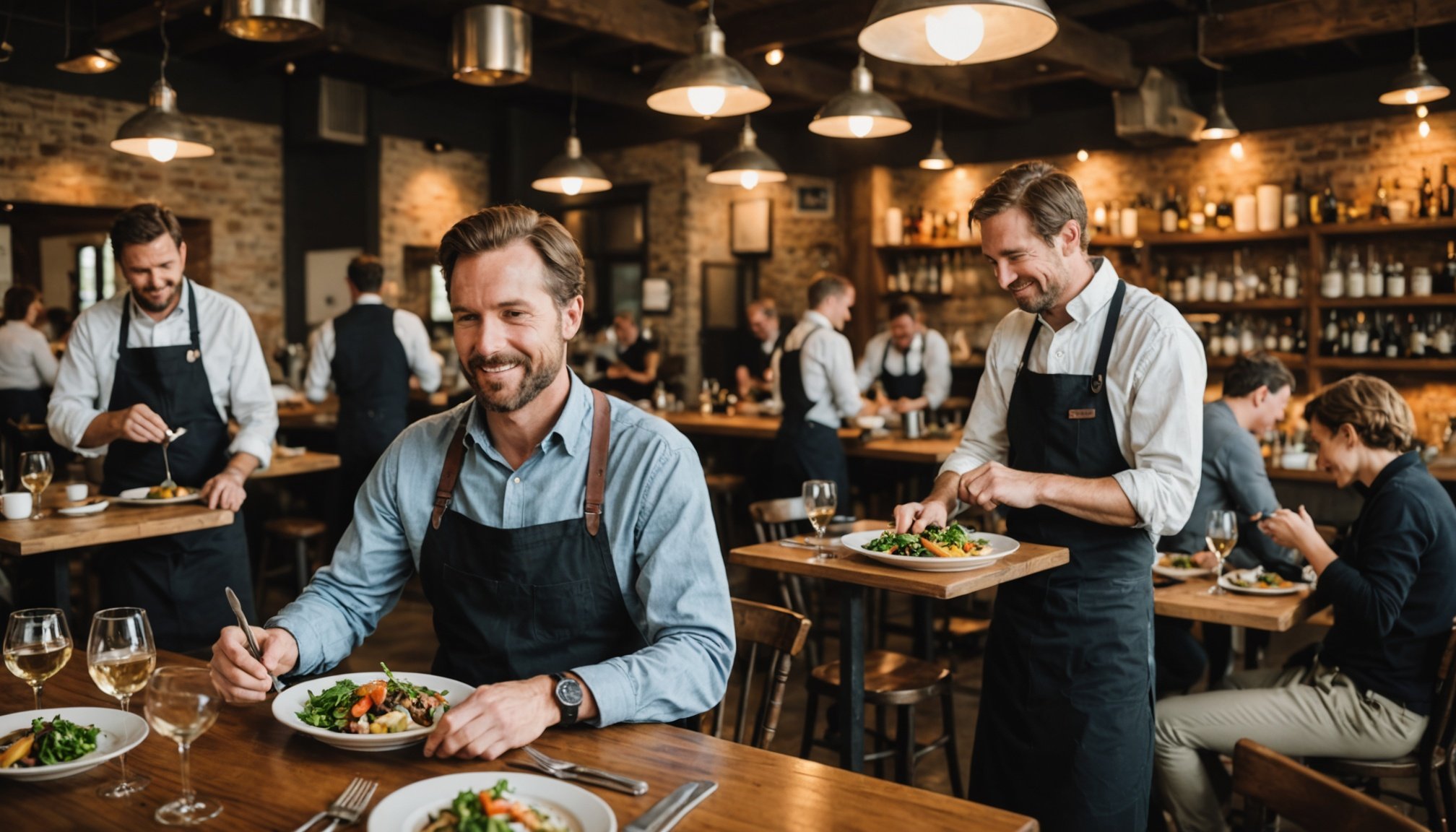Crafting a farm-to-table menu is more than a trend—it's a commitment to quality and sustainability. High-end restaurants can elevate their dining experience by connecting directly with local farms, ensuring freshness and unique flavors. Prioritizing seasonal ingredients not only enhances dishes but also supports community agriculture. In this guide, discover strategies to successfully implement a farm-to-table approach, creating memorable culinary experiences that resonate with discerning diners. Embrace this opportunity to innovate and inspire while contributing to a more sustainable food system.
Understanding the Farm-to-Table Concept
Delving into sustainable dining and high-end restaurant trends.
Also to see : Mastering Seasonal Waves: Top Strategies for Successfully Managing Your Beachfront Bar”s Fluctuations
Definition and Principles of Farm-to-Table
The farm-to-table concept emphasizes sourcing ingredients directly from local farms. This approach minimizes the distance food travels, ensuring freshness and supporting local economies. At its core, it promotes transparency and a connection between consumers and producers. This movement is particularly significant in high-end restaurants, where diners expect not only exquisite flavors but also sustainability and ethical sourcing.
Importance of Sustainability in High-End Dining
In the realm of sustainable dining, high-end establishments are leading the charge. By adopting farm-to-table practices, they reduce their carbon footprint and endorse eco-friendly practices. This commitment to sustainability is not just a trend but a necessity, as consumers increasingly demand accountability in their dining choices. High-end restaurants are thus setting a standard for the industry, proving that luxury and sustainability can coexist.
In the same genre : Crafting a Dynamic Seasonal Menu: How Restaurants Can Innovate with Fresh Ingredients
Trends Driving the Farm-to-Table Movement
Several trends fuel the farm-to-table movement:
- Consumer Awareness: Growing knowledge about food origins.
- Health Consciousness: Desire for fresher, less processed foods.
- Environmental Concerns: Focus on reducing food miles and waste.
These trends highlight the evolving landscape of sustainable dining, where high-end restaurants are not just serving meals, but also stories of origin and care.
Sourcing Local Ingredients
Exploring the dynamics of local sourcing and ingredient quality in high-end dining.
Strategies for Finding Local Farms and Suppliers
High-end restaurants aiming for ingredient quality often prioritize local sourcing. This involves identifying and collaborating with nearby farms to ensure a steady supply of fresh produce. A practical approach includes visiting local farmers' markets and agricultural fairs, which serve as hubs for discovering potential partners. Building relationships with farmers is crucial, as it fosters trust and reliability. Engaging in regular communication and site visits can solidify these partnerships, ensuring that the ingredients meet the restaurant's standards.
Building Relationships with Farmers and Producers
Establishing strong connections with local farmers and producers is essential for maintaining ingredient quality. Restaurants can offer farmers consistent business and fair pricing, creating a mutually beneficial relationship. This collaboration allows chefs to plan menus around seasonal availability, enhancing the dining experience with fresh, flavorful dishes.
Ensuring Quality and Seasonality of Ingredients
The emphasis on local sourcing ensures that ingredients are not only fresh but also seasonal. This approach supports ingredient quality by allowing chefs to work with produce at its peak flavor. Seasonal menus can highlight the unique offerings of local farms, providing diners with a taste of the region's best.
- Benefits of Local Sourcing:
- Fresher ingredients
- Reduced environmental impact
- Support for local economies
By focusing on these strategies, high-end restaurants can elevate their commitment to sustainability and quality.
Menu Development Strategies
Exploring how to craft menus that captivate and satisfy.
Creating a Seasonal Menu Reflecting Local Availability
Designing a seasonal menu requires a keen understanding of what local farms can provide throughout the year. Chefs should align their offerings with the availability of fresh produce, ensuring that each dish showcases the best of what the region has to offer. This not only enhances flavor but also supports sustainability by reducing the need for long-distance transportation.
Incorporating Innovative Culinary Techniques
By leveraging culinary creativity, chefs can transform local ingredients into extraordinary dishes. Techniques such as sous-vide, fermentation, and molecular gastronomy can elevate traditional recipes, offering diners a unique experience. This approach allows for the exploration of textures and flavors, making each meal memorable and distinct.
Balancing Creativity and Customer Preferences
While culinary creativity is essential, it's important to consider customer preferences. Striking a balance between innovation and what diners enjoy can be challenging. However, by staying attuned to feedback and trends, restaurants can craft menus that are both inventive and appealing.
- Menu Design Tips:
- Highlight seasonal produce
- Use diverse cooking methods
- Consider customer feedback
By focusing on these strategies, high-end restaurants can create menus that are not only innovative but also resonate with their clientele.
Pricing Strategies for Farm-to-Table Menus
Exploring cost management and value perception in high-end dining.
Understanding the Cost Implications of Local Sourcing
Sourcing locally for a farm-to-table menu can often lead to higher costs due to the premium placed on ingredient quality and seasonal availability. These expenses can impact the overall pricing of dishes. However, this investment ensures freshness and supports local economies, which can be a significant selling point for diners who value sustainability.
Communicating Value to Customers Effectively
To justify the pricing of high-end farm-to-table dishes, it's crucial to communicate the value proposition clearly. Diners should understand that the cost reflects the quality, ethical sourcing, and the unique flavors of locally sourced ingredients. Sharing the story of the ingredients' journey from farm to plate can enhance the dining experience and build trust.
Strategies for Pricing High-End Farm-to-Table Dishes
Developing effective pricing strategies involves balancing costs with customer expectations. Consider these approaches:
- Tiered Pricing: Offer dishes at various price points to appeal to different budgets.
- Value-Added Services: Include complimentary items or experiences to enhance perceived value.
- Transparent Pricing: Clearly explain how costs are allocated, emphasizing the benefits of local sourcing.
By employing these strategies, high-end restaurants can manage costs while maintaining a positive value perception among customers.
Enhancing Customer Experience
Creating memorable dining encounters through engagement and storytelling.
Creating a Narrative Around the Farm-to-Table Experience
High-end restaurants can enhance the dining experience by crafting a compelling narrative about their farm-to-table journey. This storytelling approach connects diners to the origins of their meals, transforming a simple dinner into an educational and engaging event. Sharing details about the farmers, the local sourcing process, and the journey of ingredients can captivate customers, making their meal more meaningful.
Incorporating Educational Elements About Local Sourcing
To further enrich the customer engagement, restaurants can integrate educational elements into the dining experience. This might include informative menu inserts or interactive discussions with chefs about the benefits of local sourcing. Such initiatives not only inform but also foster a deeper appreciation for the farm-to-table philosophy, enhancing the overall dining experience.
Engaging Customers Through Special Events and Tastings
Special events and tastings offer unique opportunities for customer engagement. By hosting farm tours, cooking classes, or exclusive tastings, restaurants can deepen the connection between diners and the farm-to-table process. These events provide a platform for storytelling and allow customers to experience firsthand the quality and care involved in local sourcing.
- Engagement Strategies:
- Farm tours
- Cooking classes
- Exclusive tastings
By focusing on these aspects, restaurants can significantly enhance the customer experience.
Overcoming Challenges in Implementation
Navigating the hurdles of farm-to-table execution in high-end dining.
Common Challenges Faced by High-End Restaurants
High-end restaurants often encounter several challenges when implementing the farm-to-table concept. These include inconsistent ingredient supply, high costs, and logistical issues. Seasonal availability may lead to menu limitations, while maintaining ingredient quality can be demanding. Additionally, building and sustaining relationships with local farmers requires time and effort.
Solutions and Best Practices for Overcoming Challenges
To address these challenges, restaurants can adopt several solutions. Establishing a diverse network of local suppliers ensures a consistent supply of ingredients. Investing in storage solutions can mitigate seasonal shortages. Collaborating with farmers to plan crop cycles aligns with menu needs. Implementing robust communication channels fosters strong partnerships, while adaptability allows for quick menu adjustments.
- Best Practices:
- Diversify supplier networks
- Invest in storage solutions
- Collaborate on crop planning
Importance of Adaptability and Feedback in the Process
Adaptability is crucial for high-end restaurants to thrive in the farm-to-table landscape. Regular feedback from customers and suppliers informs necessary adjustments. This iterative process enhances customer satisfaction and ensures the restaurant maintains its commitment to sustainability. By embracing change and learning from experiences, restaurants can effectively navigate the challenges of farm-to-table execution.











